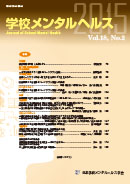[Purpose]
This study aimed to develop a psychoeducational program to deepen emotional self-understanding as a part of social skills training for junior high school students experiencing difficulties with interpersonal relationships.
[Methods]
We established eight sub-goals and conducted the program five times to achieve the same. The program participants were ten junior high school students (five male, five female) who were signed up for the social skills program due to low levels of awareness in their interpersonal relationships. The group of ten students included those who had been diagnosed by specialized institutions with high-functioning autism, Asperger’s syndrome, and attention deficit hyperactivity disorder (ADHD), among others. The program was conducted separately for boys and girls. To examine the results of the program, we collected participants’ descriptive writing samples which included reflections on and measurements of emotional intelligence and psychological responses to stress.
[Results]
For emotional intelligence, a paired t-test showed that scores for the two items “When something happens, I usually understand why I felt the way I did” and “I am good at controlling my own emotions” were significantly greater after the program implementation compared with the pre-test scores, and the effect size was medium. For psychological stress responses, a one-way analysis of variance (ANOVA) with correspondence showed a significant effect of time (time 1–time 4) on the emotional responses of “anger” and “anxiety,” as well as the secondary response of “dependence.” The effect size for “anxiety” was large and those for “anger” and “dependence” were medium to large. The results of multiple comparisons suggested that for “anger” and “anxiety,” stress was found to have reduced after the fourth time in the program, when compared with the first time.
[Discussion/Conclusion]
We investigated the following four points: (1) the effect of deepened emotional self-understanding following the program; (2) the impact on the emotional understanding of others; (3) the impact on exercising emotional control; and (4) the impact on reducing stress responses as a derivative effect of the program. For (1), (3), and (4), the achieved results partially supported the effectiveness of the program. For (2), there was no effect on the emotional understanding of others with the emotional self-understanding program alone. Rather, it was shown that in order to apply emotional self-understanding skills to understand others in interpersonal situations, it was necessary to implement a social skills program in combination with a program for emotional understanding of others based on the program for personal emotional understanding. Since there were few participants in this study, the results must be carefully interpreted. While aiming to improve the program, the challenge of replicating the program’s implementation and testing the effects of the program in the future remains.
View full abstract
